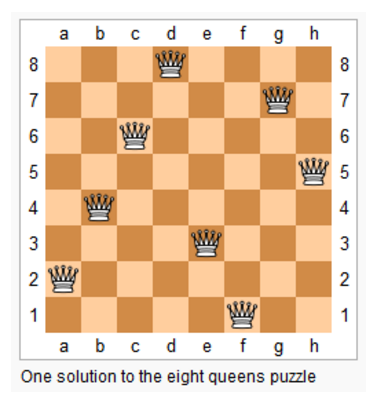Description
The n-queens puzzle is the problem of placing n queens on an n×n chessboard such that no two queens attack each other.

Given an integer n, return all distinct solutions to the n-queens puzzle.
Each solution contains a distinct board configuration of the n-queens' placement, where 'Q' and '.' both indicate a queen and an empty space respectively.
Example
For example,
There exist two distinct solutions to the 4-queens puzzle:
[
[".Q..", // Solution 1
"...Q",
"Q...",
"..Q."],
["..Q.", // Solution 2
"Q...",
"...Q",
".Q.."]
]
思路
- 按照剑指offer上比较low的思路,先将所有的排列求出来,然后判断每个排列是否满足条件
- 递归方式
代码
- 求出所有排列后判断
class Solution {
public:
vector<vector<string>> solveNQueens(int n) {
vector<vector<string>> res;
if(n == 0) return res;
vector<int> nums(n);
for(int i = 0; i < n; ++i)
nums[i] = i;
do{
if(isValid(nums, n)){
vector<string> str;
generate(nums, n, str);
res.push_back(str);
}
}while(getNextPermutation(nums, n));
return res;
}
private:
bool getNextPermutation(vector<int> &nums, int len){
int index1 = 0, index2 = -1, flag = -1;
for(int i = 1; i < len; ++i){
if(nums[i] > nums[i - 1]){
index1 = i - 1;
index2 = i;
flag = nums[i] - nums[i - 1];
}
else if(nums[i] > nums[index1] && nums[i] - nums[index1] < flag){
index2 = i;
flag = nums[i] - nums[index1];
}
}
if(index2 == -1) return false;
swap(nums[index1], nums[index2]);
sort(nums.begin() + index1 + 1, nums.end());
return true;
}
bool isValid(vector<int> &nums, int len){
for(int i = 0; i < len; ++i){
for(int j = i + 1; j < len; ++j){
if(i - j == nums[i] - nums[j] || j - i == nums[i] - nums[j])
return false;
}
}
return true;
}
void generate(vector<int>& nums, int len, vector<string> &str){
for(int i = 0; i < len; ++i){
string tmp(len, '.');
tmp[nums[i]] = 'Q';
str.push_back(tmp);
}
}
};
class Solution {
public:
vector<vector<string>> solveNQueens(int n) {
vector<vector<string>> res;
if(n == 0) return res;
vector<string> nums(n, string(n, '.'));
solve(res, nums, n, 0);
return res;
}
private:
void solve(vector<vector<string>> &res, vector<string> &nums, int n, int rows){
if(rows == n){
res.push_back(nums);
return;
}
for(int cols = 0; cols < n; ++cols){
if(isValid(nums, rows, cols, n)){
nums[rows][cols] = 'Q';
solve(res, nums, n, rows + 1);
nums[rows][cols] = '.';
}
}
}
bool isValid(vector<string> &nums, int rows, int cols, int n){
for(int i = 0; i != rows; ++i){
if(nums[i][cols] == 'Q')
return false;
}
for(int i = rows- 1, j = cols - 1; i >= 0 && j >= 0; --i, --j)
if(nums[i][j] == 'Q')
return false;
for(int i = rows - 1, j = cols + 1; i >= 0 && j < n; --i, ++j)
if(nums[i][j] == 'Q')
return false;
return true;
}
};